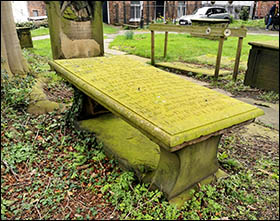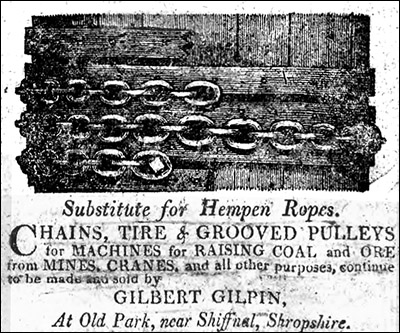Wrexham grave of Gilbert Gilpin
Gilbert Gilpin, d.1827
 The Industrial Revolution had recently started when Gilbert Gilpin was born in 1766. His father Benjamin was the clerk at Bersham ironworks, which then belonged to Isaac Wilkinson. Benjamin died in 1793 and was buried here with his wife Elizabeth, who had died in 1779.
The Industrial Revolution had recently started when Gilbert Gilpin was born in 1766. His father Benjamin was the clerk at Bersham ironworks, which then belonged to Isaac Wilkinson. Benjamin died in 1793 and was buried here with his wife Elizabeth, who had died in 1779.
Isaac’s son John was a shrewd innovator and businessman. Bersham ironworks thrived under John’s management. It led the world in precision boring of cannons in the 1770s. It directly contributed to the advance of steam engines because it was the only place capable of producing the cylinders for Boulton & Watt’s revolutionary design.
Gilbert became John Wilkinson’s chief clerk at the age of 20. Gilbert’s work included developing iron chains which were strong enough to replace ropes for high-tension applications.
He eventually left in 1796 after tiring of John’s eccentric and often autocratic management style. He remained a close friend of John’s brother William, who spent much of his time abroad advising governments on industrial development. After a few months working for Boulton & Watt, Gilbert took up a post at Sirhowy ironworks, Tredegar, the remains of which are a Scheduled Ancient Monument.
 In the early 19th century, he was best known as an owner of ironworks in Shropshire. In 1805 he had received a silver medal and 30 guineas from the Society for the Encouragement of Arts, Manufacturers and Commerce for a “crane for raising weights”. In 1808 his colliery winding technology, using chains instead of ropes, was said to cost one-third less to operate than the “common cylindrical” alternative.
In the early 19th century, he was best known as an owner of ironworks in Shropshire. In 1805 he had received a silver medal and 30 guineas from the Society for the Encouragement of Arts, Manufacturers and Commerce for a “crane for raising weights”. In 1808 his colliery winding technology, using chains instead of ropes, was said to cost one-third less to operate than the “common cylindrical” alternative.
Britain’s wars with France boosted his trade because it was harder to import hemp for ropemaking. The picture shows one of his newspaper adverts from 1810 aimed at “Proprietors of Mines, &c”.
Gilbert was compiling a Welsh dictionary before he died in 1827.

